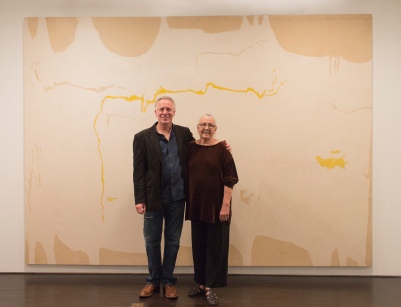EDWARD DUGMORE: THE SIXTIES, ESSAY BY LORETTA HOWARD GALLERY DIRECTOR, HOWARD HURST
by leslierankowfinearts
THE ART OF PUBLISHING TRAVELS AN EVER CHANGING LANDSCAPE AS WE BECOME INCREASINGLY EMBEDDED IN THE DIGITAL WORLD. MANY FACTORS ARE AT WORK: PRODUCTION COSTS, PAPER, INK, PRINTING AND BINDING ARE SIGNIFICANT EXPENSES AND AUTHOR FEES, REPRODUCTION RIGHTS, DESIGN COSTS AND DISTRIBUTION ADD TO THE FINANCIAL BURDEN OF THE TRADITIONAL PUBLICATION. ACCORDING TO A STUDY BY INDEPENDENT JOURNALIST, JUDITH DOBRZYNSKI, WHO WRITES ON CULTURE IN THE ARTS JOURNAL, AS FEW AS 2% OF PEOPLE VISITING A MUSEM EXHIBITION USUALLY BUY THE CATALOGUE. IN GENERAL, THE WAY IN WHICH WE ABSORB INFORMATION HAS CHANGED RADICALLY FROM PHYSICAL TO DIGITAL.
THE UNALTERABLE INTRINSIC VALUE OF DOCUMENTING AN EXHIBITION, WHETHER IN DIGITAL OR PRINTED FORMAT, IS TO MEMORIALIZE ITS CONTENT AND THE CURATORIAL PERSPECTIVE OF THE SHOW. THESE INSIGHTS PROVIDE A DEEPER UNDERSTANDING OF THE ARTWORK AND THE SCHOLARLY CONTRIBUTION OF AN ESSAY OR ESSAYS OFFERS A FRESH AWARENESS OF AN ARTIST’S SIGNIFICANCE THAT ENRICHES OUR ART HISTORICAL UNDERSTANDING.
THE CATALOGUE ESSAY FOR THE CURRENT EXHIBITION AT THE LORETTA HOWARD GALLERY: EDWARD DUGMORE: THE SIXTIES, DOES JUST THAT. WRITTEN BY GALLERY DIRECTOR, HOWARD HURST, IT INFORMS US ABOUT THE INFLUENCES AT WORK DURING THIS IMPORTANT DECADE OF HIS PICTORIAL CAREER. THE EXHIBITION CONTINUES THROUGH MARCH 25th AT 521 WEST 26th STREET IN CHELSEA.
THE LRFA BLOG IS VERY PLEASED TO POST THE ESSAY AND THANK HOWARD HURST FOR HIS CONTRIBUTION.
EDWARD DUGMORE: THE SIXTIES
When Edward Dugmore arrived in Manhattan in the mid 1950s he helped define a generation of Abstract Expressionist painters who’s legacy is now mythic in scale. This was an inward looking period known for its hard drinking, heated debate and cathartic, frenzied painting. Dugmore became a ubiquitous figure at the Cedar Street Tavern and the many downtown artist cooperatives that helped define this scene. By 1960 however, the fabric of this milieu had changed. Dugmore’s close friend Clyfford Still left that year to paint in pastoral isolation on his farm in Westminster, Maryland. Willem de Kooning began spending increasingly more time in the rural hamlet of East Hampton before moving there permanently in 1971. Phillip Guston would abandon pure abstraction and take up permanent residence in the Catskill Mountains.
For Dugmore, this decade would also mark an important turning point in his practice. His paintings of the 1960s mark a shift away from the urbanism and introspection of the 1950s. Instead, they capture a sense of openness and reflection as the artist rediscovered the American landscape, in particular the American West and Coastal Maine. These works avoid literal depiction and instead embody the emotional and spiritual impact of the natural world.
For Dugmore, the Rocky Mountains, which he experienced as a visiting artist to the Aspen School of Art in 1961, became a mystic symbol. His paintings from this period stretch themselves out in stark fields of mottled black and white, shot through with sinuous skeins of brilliant color. The resulting silhouettes feel ancient and geological in nature but resist direct recognition. We feel the bodily impact of vast, humbling space and the unknowable force of the wilderness.

Edward Dugmore’s grandson Wolf Bowart and daughter Linda Shannon Dugmore
OPENING RECEPTION
FEBRUARY 23, 2017
EDWARD DUGMORE: THE SIXTIES, FEBRUARY 23- MARCH 25, AT LORETTA HOWARD GALLERY, 521 West 26th ST, NY
THE AUTHOR
HOWARD HURST, DIRECTOR OF LORETTA HOWARD GALLERY, REGULAR CONTRIBUTOR TO hyperallergic.com
HOWARD OBTAINED HIS MASTERS IN CURATORIAL STUDIES AND MUSEUM SCIENCES FROM SETON HALL UNIVERSITY. WHILE IN GRADUATE SCHOOL, HE WORKED AT THE NEW MUSEUM BEFORE BEGINNING HIS CAREER IN NEW YORK AT THE ALAN STONE GALLERY.
TO ADD TO YOUR UNDERSTANDING OF DUGMORE’S WORK, HERE IS HOWARD HURST’S CATALOGUE ESSAY FOR DUGMORE’S 2014 RETROSPECTIVE AT THE GALLERY. THIS CATALOGUE FOCUSES ON THE TWO MOST IMMEDIATE AND OBVIOUS CONNECTIONS PEOPLE MAKE TO THE WORK OF EDWARD DUGMORE, THAT OF HIS TEACHER THOMAS HART BENTON AND HIS TEACHER AND FRIEND, CLYFFORD STILL.
ANCIENT EVENINGS: A RETROSPECTIVE OF EDWARD DUGMORE, LORETTA HOWARD GALLERY, APRIL 2014





Once again, a really lovely post. So glad you addressed the publishing issue. Thank you.
Thank you for contributing to the blog, and everyone in the gallery’s efforts to make it as good as possible!
I’m happy to highlight Edward Dunmore’s exhibition and the beautiful accompanying catalogue.
I haven’t checked in here for a while because I thought it was getting boring, but the last few posts are good quality so I guess I will add you back to my everyday bloglist. You deserve it my friend 🙂
Many thanks!